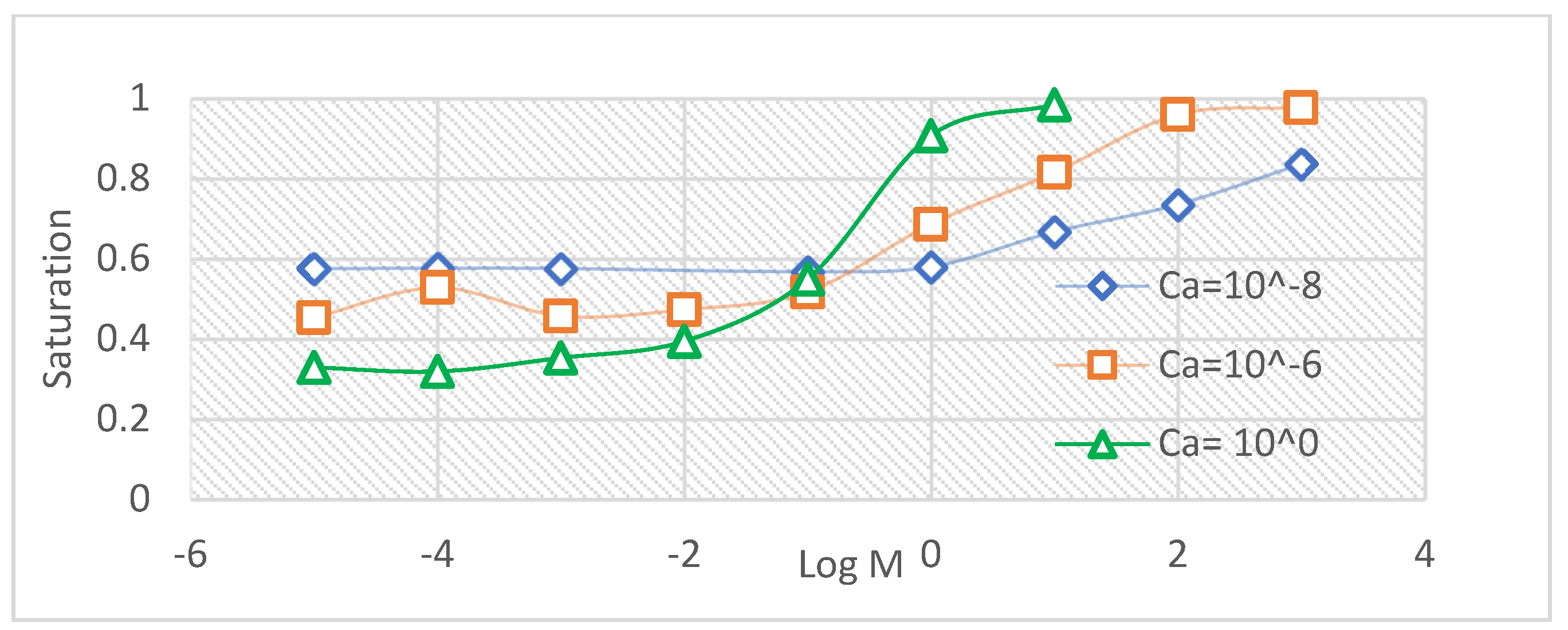Pore Network Modelling of Porous Media for Carbon Dioxide Sequestration: A Case Study of Pakistan †
Abstract
:1. Introduction
2. Method and Materials
2.1. Porous Medium Geometry
2.2. Flow of Fluid across Network
3. Results and Discussion
Estimation of CO2 Quantity
4. Conclusions
Author Contributions
Funding
Data Availability Statement
Conflicts of Interest
References
- Ellis, J.S.; Bazylak, A. Dynamic pore network model of surface heterogeneity in brine-filled porous media for carbon sequestration. Phys. Chem. Chem. Phys. 2012, 14, 8382–8390. [Google Scholar] [CrossRef] [PubMed]
- Rashid, M.I.; Benhelal, E.; Rafiq, S. Reduction of greenhouse gas emissions from Gas, oil, and coal power plants in Pakistan by carbon capture and storage (CCS). Chem. Eng. Technical. 2020, 43, 1–10. [Google Scholar] [CrossRef]
- Shamsul, M.; Ishfaq, A. Task Force on Climate Change; Planning Commission Government of Pakistan: Islamabad, Pakistan, 2010.
- Holloway, S.; Garg, A.; Kapshe, M.; Deshpande, A.; Pracha, A.S.; Khan, S.R.; Mahmood, M.A.; Singh, T.N.; Kirk, K.L.; Gale, J. An assessment CO2 storage potential of subcontinent. Energy Procedia 2009, 1, 2607–2613. [Google Scholar] [CrossRef] [Green Version]
- Benson, S.M.; David, D.R. CO2 Sequestration in Deep Sedimentary Formations. Clay Miner. Soc. 2008, 4, 325–331. [Google Scholar] [CrossRef]
- Gaus, I. Role & impact of CO2–rock CO2 storage in sedimentary rocks. Int. J. Greenh. Gas Control 2010, 4, 73–89. [Google Scholar]
- Saadatpoor, E.; Bryant, S.L.; Sepehrnoori, K. New Trapping Mechanism in Carbon Sequestration. Transp. Porous Media 2010, 82, 3–17. [Google Scholar] [CrossRef]
- Aker, E.; Maloy, K.J. A Two-Dimensional Network Simulator for 2-Phase. Transp. Porous Media 1998, 32, 163–186. [Google Scholar] [CrossRef]
- Lecomte, F.; Broutin, P.; Lebas, E. Pore-level modeling of CO2 sequestration. In Proceedings of the 1st National Conference on Carbon Seq, Washington DC, USA, 7–10 May 2001. [Google Scholar]
- Li, L.; Peters, C.A.; Celia, M.A. Upscaling geochemical reaction rates. Adv. Water Resour. 2006, 29, 1351–1370. [Google Scholar] [CrossRef]
- Silin, D.; Tomutsa, L.; Benson, S.M.; Patzek, T.W. Microtomography and Pore-Scale Modeling. Transp. Porous Media 2011, 86, 495–515. [Google Scholar] [CrossRef] [Green Version]
- Blunt, M.J.; Scher, H. Pore-level modeling of wetting. Phys. Rev. E 1995, 52, 6387. [Google Scholar] [CrossRef]
- Al-Futais, A.; Patzek, T.W. Impact of wettability alteration on two-phase flow. Water Resour. Res. 2003, 39. [Google Scholar] [CrossRef]
- Perrin, C.L.; Tardy, P.M.; Sorbie, K.S.; Crawshaw, J.C. Experimental and modelling study of Newtonian’s. J. Coll Interface Sci. 2006, 295, 542–550. [Google Scholar] [CrossRef] [PubMed]

| Throat Radius (mm) | Porosity | Permeability (mD) | Differential Pressure (MPa) |
| 0.05–1 | 0.17 | 30 | 10 |
| Surface Tension (γ) | Contact Angle (θ) | Defending Viscosity (Pa-s) | Invading Viscosity |
| 0.021 N/m | 31 | 10−3 | 10−4 |
| Network Size | Saturated Volume (m3) | Estimation of CO2 (grams) |
| 50 × 50 | 0.212038 | 381.23 |
| 100 × 100 | 0.865550812 | 1556 |
| 150 × 150 | 1.9606 | 3525 |
| 200 × 200 | 3.53735 | 6359.8 |
| 250 × 250 | 5.475 | 9844.4 |
| 300 × 300 | 7.895 | 14194 |
Publisher’s Note: MDPI stays neutral with regard to jurisdictional claims in published maps and institutional affiliations. |
© 2022 by the authors. Licensee MDPI, Basel, Switzerland. This article is an open access article distributed under the terms and conditions of the Creative Commons Attribution (CC BY) license (https://creativecommons.org/licenses/by/4.0/).
Share and Cite
Sheikh, N.A.; Ullah, I.; Ali, M. Pore Network Modelling of Porous Media for Carbon Dioxide Sequestration: A Case Study of Pakistan. Eng. Proc. 2021, 12, 64. https://doi.org/10.3390/engproc2021012064
Sheikh NA, Ullah I, Ali M. Pore Network Modelling of Porous Media for Carbon Dioxide Sequestration: A Case Study of Pakistan. Engineering Proceedings. 2021; 12(1):64. https://doi.org/10.3390/engproc2021012064
Chicago/Turabian StyleSheikh, Nadeem Ahmed, Irfan Ullah, and Muzaffar Ali. 2021. "Pore Network Modelling of Porous Media for Carbon Dioxide Sequestration: A Case Study of Pakistan" Engineering Proceedings 12, no. 1: 64. https://doi.org/10.3390/engproc2021012064
APA StyleSheikh, N. A., Ullah, I., & Ali, M. (2021). Pore Network Modelling of Porous Media for Carbon Dioxide Sequestration: A Case Study of Pakistan. Engineering Proceedings, 12(1), 64. https://doi.org/10.3390/engproc2021012064








